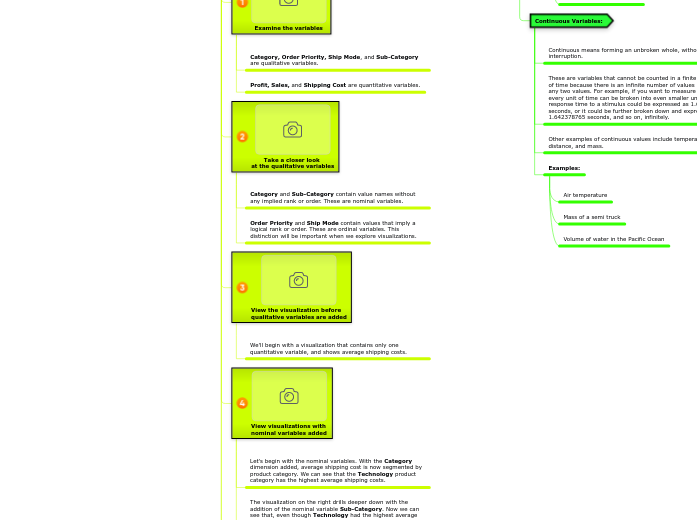Exploring Variables and Field Types
Understanding variables and field types
Types of qualitative variables
Nominal: Categories that cannot be ranked.
Example:
(Bananas, grapes, apricots, and apples)
These fruits would be considered nominal qualitative variables because there is no implied ranked order among them.
Ordinal: In contrast, these categories can be ranked.
Example:
(Never, rarely, sometimes, often, always)
These are ordinal qualitative variables. They are
qualitative because they are not numerically measurable.
However, they have an implied ranked order among them.
Note: At times, ordinal values are given numeric equivalents (5 = Extremely satisfied, for example) and then are treated as quantitative values.
View variables in visualizations
Quantitative variables: this type of data can be calculated. They can also be aggregated (sum and average).
Qualitative variables: this type of data can set the level of detail in the visualization. They can be used to categorize, segment, and reveal the details in your data.

The visualization on the left includes only a quantitative variable (Profit) while the visualization on the right includes a quantitative variable (Profit) and a qualitative variable (Category).

Examine the variables
Category, Order Priority, Ship Mode, and Sub-Category are qualitative variables.
Profit, Sales, and Shipping Cost are quantitative variables.

Take a closer look
at the qualitative variables
Category and Sub-Category contain value names without any implied rank or order. These are nominal variables.
Order Priority and Ship Mode contain values that imply a logical rank or order. These are ordinal variables. This distinction will be important when we explore visualizations.

View the visualization before
qualitative variables are added
We'll begin with a visualization that contains only one quantitative variable, and shows average shipping costs.

View visualizations with
nominal variables added
Let's begin with the nominal variables. With the Category dimension added, average shipping cost is now segmented by product category. We can see that the Technology product category has the highest average shipping costs.
The visualization on the right drills deeper down with the addition of the nominal variable Sub-Category. Now we can see that, even though Technology had the highest average shipping costs by product category, Tables have highest average shipping costs by product sub-category.

View a visualization with
an ordinal variable added
Now let's see what happens when we explore another visualization, one that uses an ordinal variable to analyze average shipping costs by Order Priority.
What do you notice? Surprisingly, low-priority orders have higher average shipping costs than medium-priority orders do.

View a visualization with a
second ordinal variable added
Adding a second ordinal variable enables us to analyze average shipping costs by both Order Priority and Ship Mode.
What do you notice? Surprisingly, for medium-priority orders, orders shipped first class have higher average shipping costs than orders shipped same day.
Discrete and continuous variables
Discrete Variables:
Discrete variables are individually separate and distinct. Simply stated, if you can count it individually, it is a discrete variable. For example, you can count the number of children in a household individually. A household can have 0 children, 3 children, 6 children, and so on, but it can not have 3.45 children.
The number of toes on a foot and the total number of socks in a drawer are also examples of discrete variables. The total number of toes on all the feet of all the people in your city is even a discrete variable. It would take a long time to individually count all those toes, but it's still possible to do so.
Examples:
Number of students in a class
Number of horses in South America
Number of eggs in a carton
Continuous Variables:
Continuous means forming an unbroken whole, without interruption.
These are variables that cannot be counted in a finite amount of time because there is an infinite number of values between any two values. For example, if you want to measure time, every unit of time can be broken into even smaller units: The response time to a stimulus could be expressed as 1.64 seconds, or it could be further broken down and expressed as 1.642378765 seconds, and so on, infinitely.
Other examples of continuous values include temperature, distance, and mass.
Examples:
Air temperature
Mass of a semi truck
Volume of water in the Pacific Ocean
